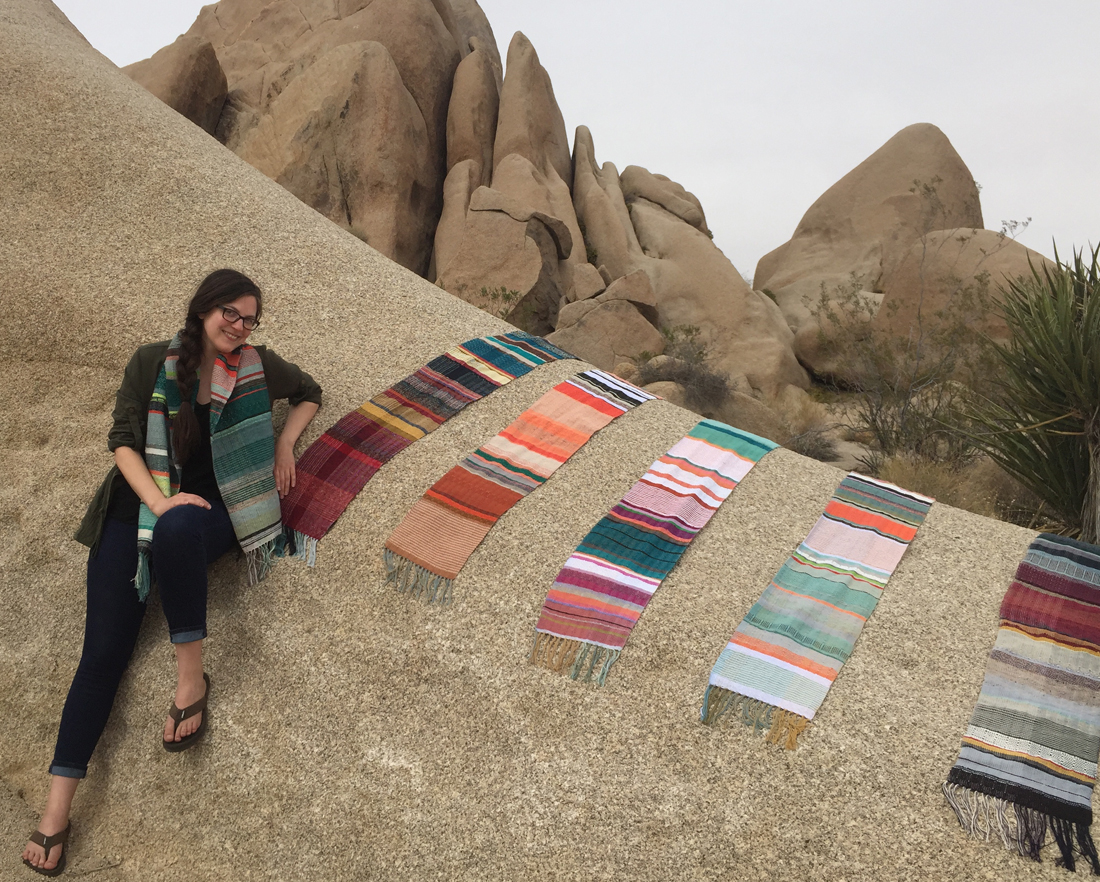
Vanessa Lauria with some of her woven scarves.
Photo by Lindsay Hollinger
Most of the skilled craftswomen I came across were creating intricately woven items in chenille and scratchy wool in limited color palettes and traditional patterns. I popped into their booths where they quietly sat, introduced myself and asked a million questions. (I think my enthusiasm surprised them. And my modern, vibrantly striped, hand-woven scarves may have offended them!) Despite our different aesthetics, though, I was eager to meet these weavers and learn their stories.
I met master weaver, Margaret Cherre, at a show several years ago. She began weaving in her late 40s from an instructor in his 80s. He’d learned to weave rag rugs with his mom during the Depression.
Shoppers were equally surprised by my hand-woven accessories and asked me a million questions! “Did you knit this?” “Where do you import your fabrics from?” “Wait, you made this on a loom?!” They didn’t realize anyone still used the looms they last saw at a colonial reenactment theme park. I met a number of women who’d inherited looms from their grandmothers and great aunts. The looms collected dust in their attics. I used to receive offers — even pleas — to come take them.
Over the last few years, however, the sentiment has changed and I’ve been encouraged and delighted, especially by social media, to find that weaving has had a colorful renewed interest.
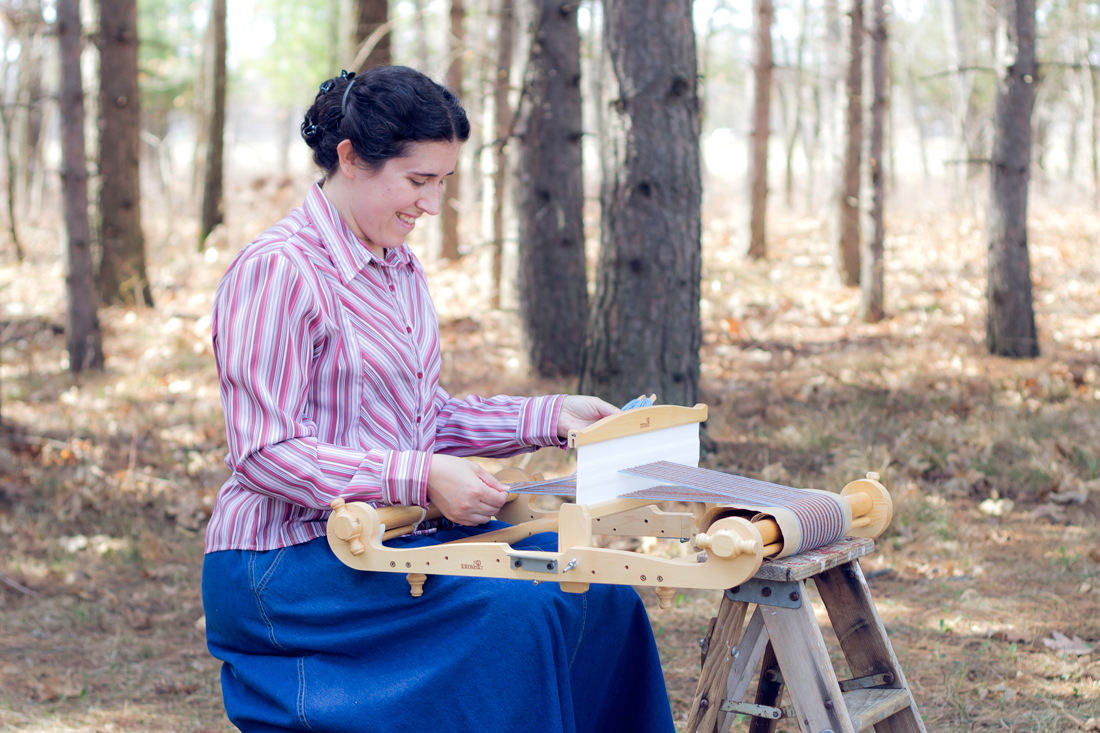
Weaver Andrea Mielke Schroer
Photo by Brittney Hobien
— Mielke Schroer
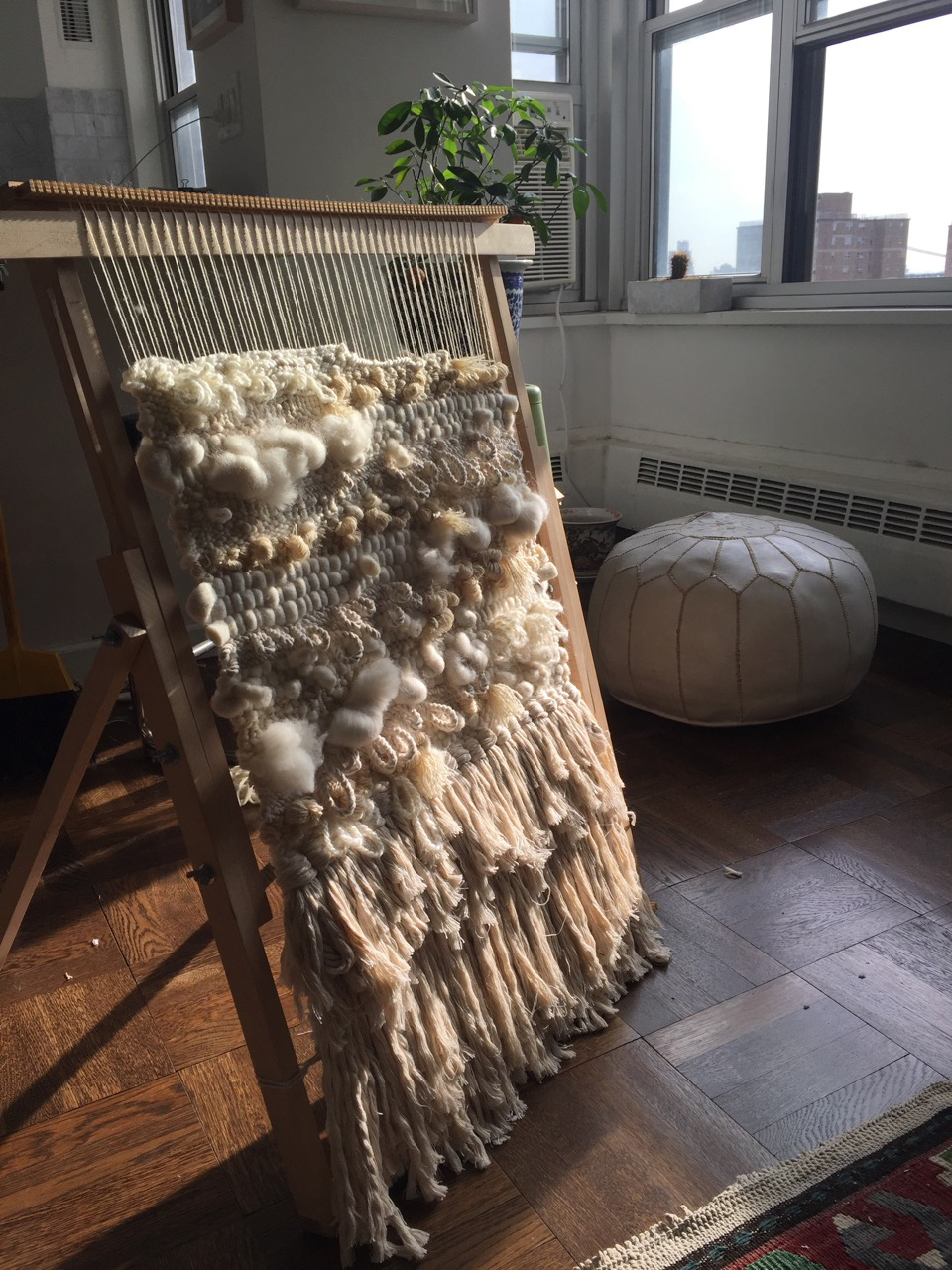
One of Toni Brogan’s commissioned tapestry wall hangings.
Photo by Toni Brogan
Unplugging and reconnecting
Our busy, technologically driven lives crave balance. Sitting in front of computers, tablets and smartphones all day can make us feel scattered and anxious. Crafting allows us to unplug from our devices and reconnect with our past — and our present.
The desire to create something with our hands isn’t a new idea. Homesteading gained popularity in the 1960s and again in recent decades. “Slow” crafting lets us feel connected with our ancestors, our ancient traditions and to the present moment. I’ve seen (and happily been a part of) a resurgence of traditional pastimes including knitting, embroidery and quilting. People are spinning and dyeing their own yarn and sewing their own clothes.
I think weaving is a natural extension of this urge to make something from scratch. Our appreciation of process-oriented pursuits grows stronger as the pace of life and technology grows ever faster.
Technology and community
Even though ubiquitous technology may be to blame for our desire to unplug, it’s also created a lively community for weaving. Imagine my surprise when I logged onto Instagram for the first time in the fall of 2012 and discovered a rich community of weavers around the world (from the United States to Australia), sharing techniques and sources for supplies. I no longer felt like a black sheep!
Instagram accounts connect modern weavers all over the world. Online communities like @theweavingkind — with almost 40,000 members — provide encouragement and facilitate experimentation, offer monthly weave-along challenges and regularly feature hobbyists and professional fiber artists. Before Instagram, people swapped ideas on Ravelry and Facebook groups.
“Technology has created this interest. People started connecting with each other and that exchange of information, [had] people realizing, ‘Hey this is an option, I could start doing this,’” says Mielke Schroer
The weaving circles of generations past have expanded without borders. All of these resources and opportunities fuel our desire to create. We no longer have to rely solely on handbooks published decades ago (although they’re still quite valuable). Nor do we have to find someone from the Great Depression to teach us. We’re having conversations across continents, sharing tips, troubleshooting and playing “show and tell” with new weaving friends.
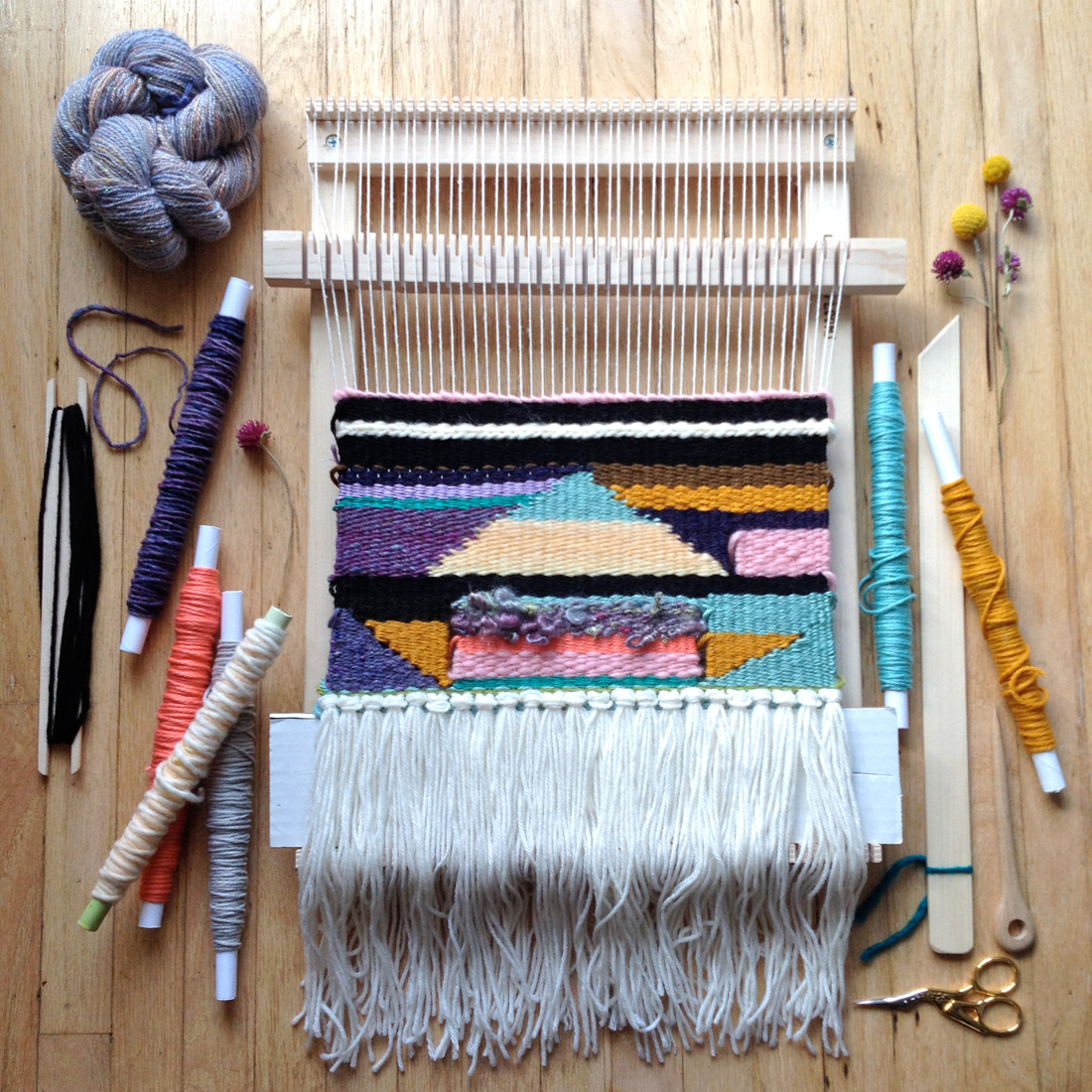
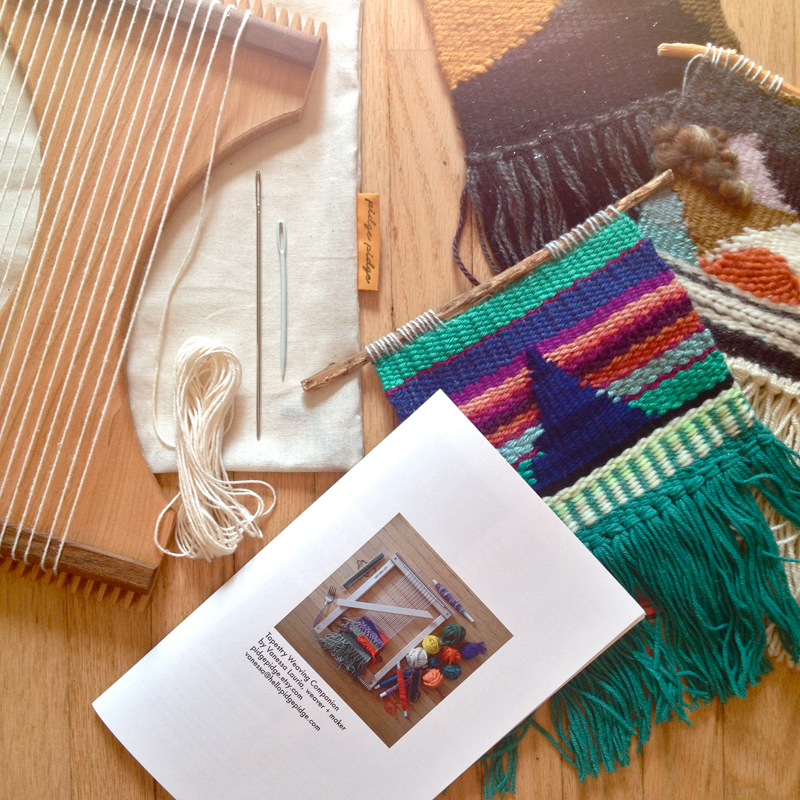
Accessibility
With a simple loom and leftover yarn from an old knitting project, anyone can weave. Past students in my tapestry workshops have included a dentist, an insurance claims adjuster, a retiree and college students. There’s a reason so many of us remember weaving on a cardboard loom or making looped potholders as young children. There are no complicated stitches to memorize, you don’t need expensive materials or an art school background. There’s instant gratification and creative possibility as every line of yarn becomes woven fabric.
People from all backgrounds and skill sets can easily learn to weave, and weaving has become less of an investment in space and cost.
“To buy a $2,000 to $3,000 loom and have space for it … it just didn’t fit,” says Mielke Schroer. “I think that’s why there’s been such a resurgence of interest in the small looms like rigid heddle looms, lap looms and frame looms … There are other options besides a big old rug loom that takes up half of the living room.”
Large floor looms aren’t practical investments for everyone, but if you want to try it, there are opportunities to do so without moving furniture. Weaving guilds offer workshops, you can rent time in studios or take private lessons. And you only have to look online to find a workshop near you or purchase a loom kit and step-by-step guide. Before the Internet, you would’ve had to read classified ads in homesteading magazines for supplies.
Collaborations and Opportunities
Renewed interest in this ancient craft is supporting the growth of the entire DIY movement. There are so many opportunities to tap into this market, even if you’re not explicitly in the weaving business.
- Spinners and dyers can supply funky textured art yarns that would be too experimental for knitters (but perfect for weavers).
- Woodworkers can handcraft weaving tools like shuttles and looms.
- Knitters, crocheters and embroidery artists can supply embellishments (like pom poms and tassels) or collaborate with weavers.
- Fabric businesses can offer strips of fabric “yarn” for making rag rugs and textured tapestries.
- Sewists can incorporate woven fabric into accessories and home decor (like clutches, apparel and decorative pillows).
- Lifestyle bloggers and craft bloggers can incorporate weaving into their photo shoots or publish tutorials for techniques and woven projects.
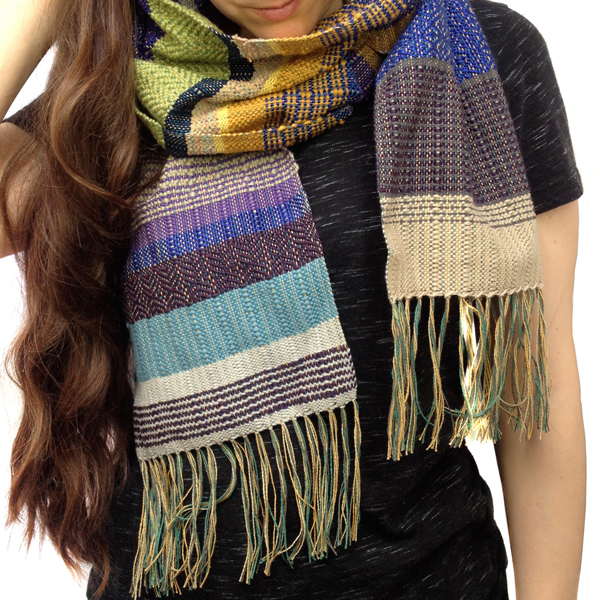
Looking beyond the trend
Mielke Schroer and her sister, Amy (Mielke) Dressel, began a small studio as teenagers — not long after that fortuitous tornado drill. Nineteen years later, their fiber arts business has grown into a successful online shop selling looms, spinning wheels and other supplies. They incorporated teaching into their business model early on, realizing that it was just as important as providing the tools and supplies.
The Mielkes grew up steeped in fiber arts and have run a business their whole adult lives. Mielke Schroer has seen first hand how craft trends ebb and flow, reemerging each time with a different twist.
“We’ve come full circle. People are doing exactly what they did back in the decade when I was born, we’re just doing it in different colors,” she says.
The general consensus of the weavers I’ve spoken to agree that its popularity is cyclical. I love that weaving has existed for thousands of years in different styles and techniques worldwide and that the Internet is bringing it all together in a fever pitch. The hand-woven goods created, from linen kitchen towels to wall hangings, are heirlooms that we’ll value and cherish long into the future.
If weaving truly is peaking right now, it will come back again — perhaps just in another iteration, with updated colors, materials or approaches to the craft. Remember those jean strips that Mielke Schroer wove with as a child? Pop onto Instagram and see how many weavers are rediscovering jean yarn; it’s becoming a thing again! Weaving will just evolve and adapt with our cultural climate. If we ever need reassurance or want predictions, look to the past and get ready for a modern spin.

Vanessa Lauria
contributor

Wonderful article Vanessa, thank you! Do you have any suggestions where to find local weaving classes or guilds? Are there any online weaving communities?
Hi Allison,
I’m glad you enjoyed the article. Thank you! The easiest answer: try googling your city (or the one closest to you) with “weaving, fiber or spinning guild” or check out the continuing education pamphlets for classes offered through local school districts. Another place that classes tend to pop up are at smaller, independent shops that offer different craft workshops (similar to the paint-your-own-pottery places). A spot in my neighborhood (makersbuffalo.com) has different classes every night, from jewelry making to glass etching. Speaking of knitting- try the local yarn shops in your area. If they don’t currently have a class, show your interest and maybe they’ll find a local instructor! Online, I’d suggest checking out @theweavingkind on Instagram. Join their newsletter & you’ll be invited to participate monthly weave-along challenges. Fibreshare.org also has great resources with an wonderful blog to connect you with weavers (as well as other fiber artists/fiber suppliers). Hope that sparks some good ideas!
Great reading, and very encouraging as I’m finding it difficult to market stuff I weave in Western Australia, where there is no established pattern of liking or purchasing handwoven stuff. This state is reportedly behind the rest of Australia in this – there are thriving businesses in Tasmania and Victoria, and others in other states. I am hoping, with limited time available to start a resurgence of affection for this oldest craft and a valuing of its products for their unique properties of design and wearability. Wish me luck!
Wonderful read! Love your items in your shop! How long does it take to make one of your scarves? Seems like it would take a long time@
Thanks so much for the kind words, Kim 🙂 It takes about 8 hours to make a scarf. I love when I can collaborate with clients on custom designs- I get to share my process and journey with them from beginning to end.
A few years ago, I volunteered to man the fiber arts guild booth at our local state fair. I brought along one of my shawls to fringe while I was there to invite conversation, along with a brick to weigh it down and a fork to push the weft threads into alignment while I tied the knots. A woman stopped, aghast..
“You made this?” Yes.” I said. “With a brick and a fork?”
That’s a great story!
Hahahaha! This is amazing. 🙂